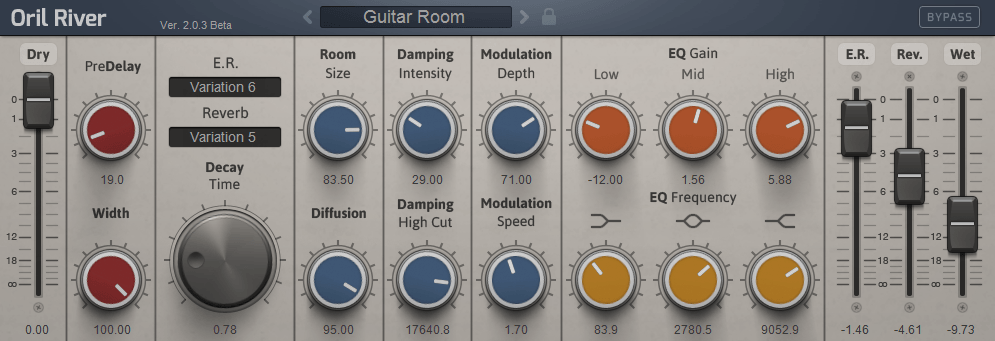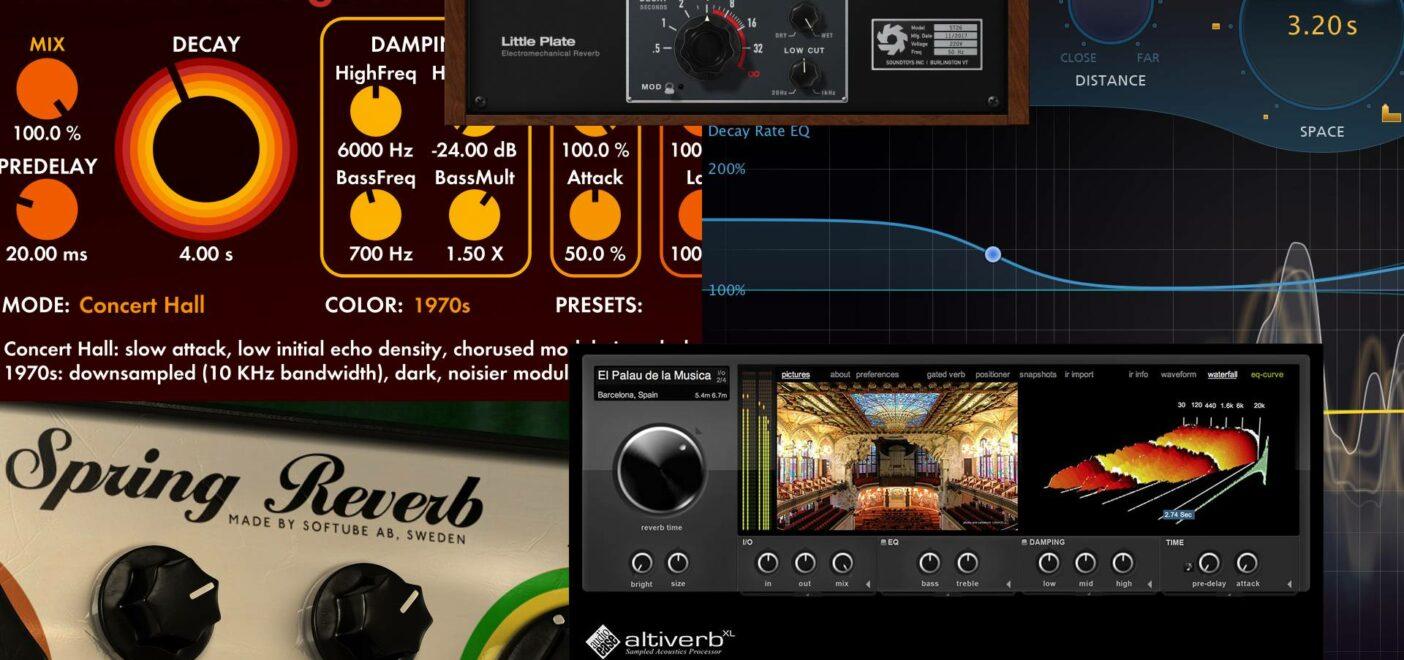When it comes to the plugin market, there is often too much choice. Whether you’re in the market for something specific or just looking for a new toy to play with, you’ll find no end of options. With things like EQ plugins, it’s understandable why there is so much variety. There are many different types of EQ that offer their own blend of coloration and control. The same can be said for compressor plugins. With a variety of circuit types available, it makes perfect sense to have a different tool for every job. But why might you want more than one reverb plugin? Surely they all do the same thing? Let’s take a look at a few concepts to familiarize ourselves with and help you find the perfect reverb plugins!
A Few Key Terms to Know
In short, there are two key designs behind a reverb plugin: algorithmic reverb plugins and convolution reverb plugins. As painfully obvious as it might be, algorithmic reverb plugins create their sound based on pre-programmed algorithms designed to replicate how a room would sound. This use of mathematics allows us to create unusual and complex spaces that we might not otherwise be able to experience.
Convolution reverbs use impulse response technology to map the physical characteristics of a real room. By using the sum and difference of a signal fed into an area, they allow us to generate an exact sonic map of that space. This can then be applied to any sound we choose, allowing us to replicate the feel of a very real and very specific environment—great for when realism is important to you.
Reverb Types
In short, there are five key types of reverb to be concerned with: Room, Hall, Chamber, Plate, and Spring. Each of these offers its own specific sound, and it’s important to understand them before investing in certain reverb plugins. For more detail, you can check out our article detailing these five types of reverb as well as more on the science of how reverb works. The more you know, the better decisions you can make!
For those of you who just want a quick overview:
- Room – Typically below 1 second, very versatile, and the most common reverb type used.
- Hall – Often up to and above 5 seconds, very large sounding spaces that tend to lack high end.
- Chamber – Typically smaller than halls, usually 1-2 seconds. Much better at maintaining high end.
- Plate – Created by vibrating a sheet of metal. Generates a very bright, sizzling sound.
- Spring – Created by vibrating a coil, producing a very distinct, oscillating sound with plenty of character.
Picking Reverb Plugins
First, you must ask yourself what you are looking to achieve. If you work with a lot of electronic music and are a fan of huge, unfathomable spaces, then some form of algorithmic hall plugin would be your best bet. However, if you spend most of your time in the recording studio and want to keep things minimal and realistic, a convolution reverb packed with great room responses is the way to go. I don’t expect you to limit yourself to such precise plugins, but I do feel that finding specific tools that excel at certain jobs tends to yield better results overall. Let’s look at some great reverb plugins, both specific and global.
Audio Ease Altiverb (Win/Mac – $560)

It really wouldn’t be an article about reverb if we didn’t talk about Altiverb. This reverb plugin was a literal game-changer when it was first released. The extent of their impulse response mapping, paired with their meticulous approach to quality, has made this plugin king. Altiverb is to reverb plugins what Pro Tools is to the DAW industry. Altiverb regularly provides updated impulse responses and seeks to offer you some of the most infamous locations in recording history. Not only this, but they now take the time to model the responses of hardware units such as Abbey Road’s famous plates or the well-known Lexicon 480L.
If you’re looking to keep things sounding natural and realistic, this is the gold standard. It isn’t cheap, but it’s well worth the price tag. Being able to model everything from the inside of a car to a cacophonous performance hall means great versatility with top-notch quality.
Soundtoys Little Plate (Win/Mac – $99)

Modeled on the original EMT 140 plate reverb, this modest offering from Soundtoys truly pushes the possibilities that analog gear couldn’t quite achieve. This beautifully sounding reverb plugin recreates the classic plate sound with such intricate accuracy that you’ll want it on everything. Not only that, but it pushes the limits of what was achievable with a real sheet of metal, allowing infinite reverb types through their modified algorithms.
Plates are fantastic, and a dedicated plate reverb plugin is totally worth having in your toolset. They are universally useful whether you work on electronic or acoustic music, as they can bring a sense of life, warmth, and energy to any source. Keep things exciting with a good plate reverb plugin when subtlety is not a priority!
Softube Spring Reverb (Win/Mac – $89)

If we’re going to look into choosing reverb plugins, it seems only appropriate to explore some of the more niche options out there. Softube makes many fantastic plugins, many of which are securely nestled in my day-to-day arsenal. One of these plugins is their spring reverb. Spring reverb offers a very unique tone and is best used sparingly to provide detail. Their simple and small design means that they are featured heavily in guitar amps. However, this doesn’t mean they don’t sound good on other sources.
This cleverly designed plugin helps to bring all the aspects of spring reverb units into one handy window. When working with real springs, you had to work with what you had in the room. If you wanted multi-spring units or both tight and loose units, you had to have them. With Softube, it comes down to dialing it in how you see fit. Adjust spring amount, tension, and overall shake to create big rattling spring reverbs or smooth, spatial masterpieces.
ValhallaDSP (Win/Mac – $50)

Typically, I would try to be decisive and attempt to pick out the best reverb plugin that Valhalla has to offer. However, I really am at a loss here. EVERYTHING this company seems to make is a must-have for me, despite looking like the console from a 1960s sci-fi spaceship. The prices are beyond fair (given that some of them are free!), and the fact that you get a plugin specific to room reverb, plate reverb, a variety of unusual modulation reverbs, and one that does it all is just insane. You’d think that there would be some overlap in the products, making some of them redundant. This is far from true.
I suppose if I had to pick just one to own, it would have to be the VintageVerb. When it comes to algorithmic reverberation, no company does it better. This spectacular reverb plugin allows the modeling of different types of rooms, as well as the coloration typical of certain musical eras. Combined with modulation tools and a built-in set of high-pass and low-pass filters, it’s a self-contained wonder verb.
OrilRiver (Win/Mac – FREE)

Perhaps you’re after something diverse like the Valhalla plugins but you don’t want to spend a cent? In this case, you’ll want to check out OrilRiver. This algorithmic reverb created by Denis Tihanov is both beautiful to look at and immensely powerful in terms of versatility. Now compatible with Mac, OrilRiver provides a highly adjustable reverb plugin with a built-in three-band EQ for sculpting perfect tone. Additionally, OrilRiver allows you to select between different settings for your early reflections and your main reverb tail. Not all reverb plugins do this, and for a freeware plugin to do it is pretty special.
By far, my favorite element of this plugin, although simple, is the solo selection buttons. Being able to solo between dry, wet, early reflection only, and reverb tail only is super useful for ensuring every element of your reverb tone sits well within a mix. Coupled with the ability to change between different variations for your early reflections and reverb, you can tweak to your heart’s content. As far as the best free reverb plugins go, this is a solid contender.
FabFilter Pro-R (Win/Mac – $199)

It’s not every day that I come across something as truly revolutionary as the FabFilter Pro-R reverb plugin. The moment I watched the trailer for this plugin, I knew I had to have it. For anyone familiar with FabFilter’s brilliant plugins, you will know that they all typically have the same interface, which is such an amazing element. The fact that even brand-new plugins can feel instantly comfortable is fantastic, especially for those of you who are still learning. When it comes to algorithmic reverb, I have saved the best for last!
What makes this so special is the way it approaches decay time and reverb EQ. Typically, most reverb plugins either have no EQ or a simple set of filter types built-in. Firstly, FabFilter has its typical parametric EQ design from the Pro-Q2 built into this plugin. This means you can EQ your reverb without the need for another plugin. Visually (and creatively), this is so much better for workflow. However, it doesn’t stop there. They have also removed the need for reverb crossover decay times. Pro-R gives you the ability to adjust decay by frequency in the same way you would with EQ. Being able to push the decay a little harder in the low-mids of a snare drum for some power and then shorten the decay in the highs to dampen splashiness is amazing. Being able to do this specific to the exact frequencies of your source signal is just phenomenal. Plus, it sounds beautiful!
TL;DR
Picking a reverb plugin can be tricky. There is so much choice and some truly amazing plugins available. With a little knowledge and understanding of your intentions, you can find the perfect tools for you. Exploring reverb plugins that give you a variety of plugin presets is great, but don’t be afraid to find something specific. Some of the best reverb plugins out there do one job really, really well. If you’d prefer to start off with one really great tool that can be used for a variety of jobs, my advice is simple. For algorithmic reverb, go with the FabFilter Pro-R. For convolution reverbs, you want the Audio Ease Altiverb.
À propos de l'auteur

Tim Dunphy
Ingénieur audio et rédacteur de contenu spécialiséPlus de 10 ans d'expérience dans le domaine de l'audio. Tout, de l'enroulement de XLR au mastering d'albums. Je suis un self-made-man et je garde mes actifs en bitcoins. Qu'y a-t-il de plus à savoir ?
Laisse un commentaire
Connecte-toi pour commenter.


